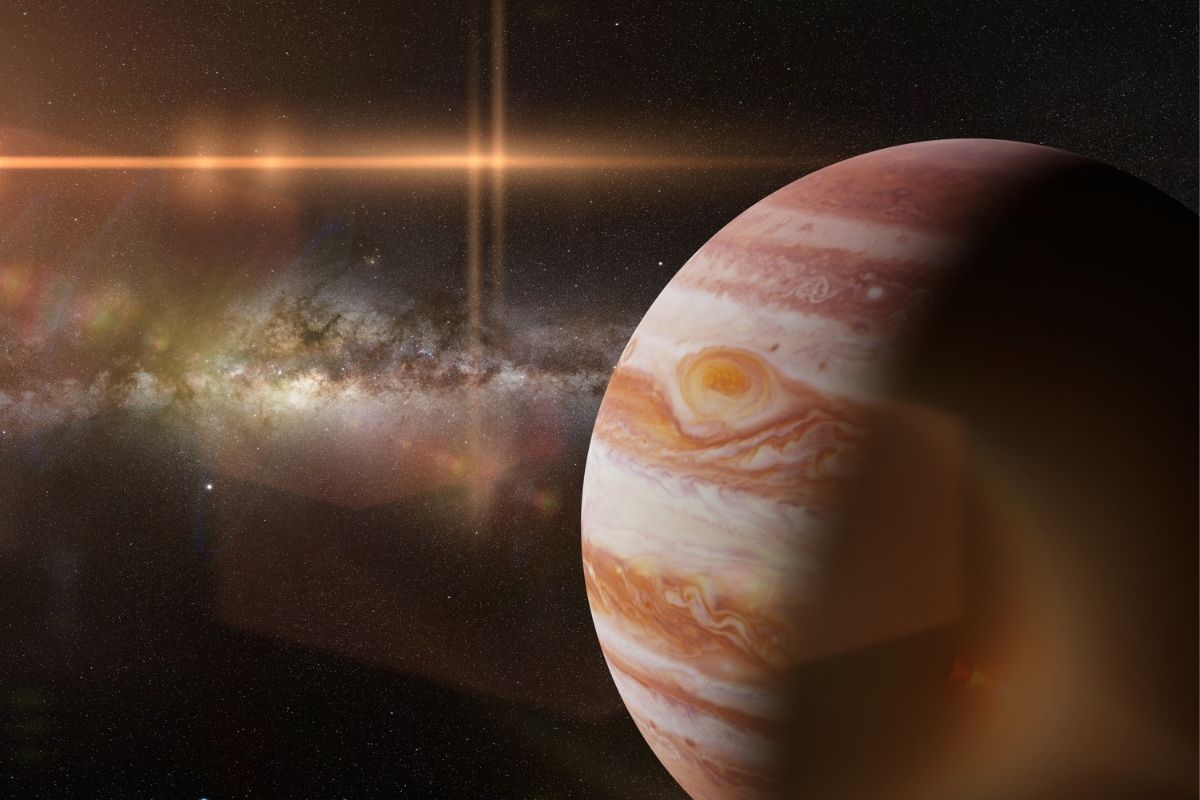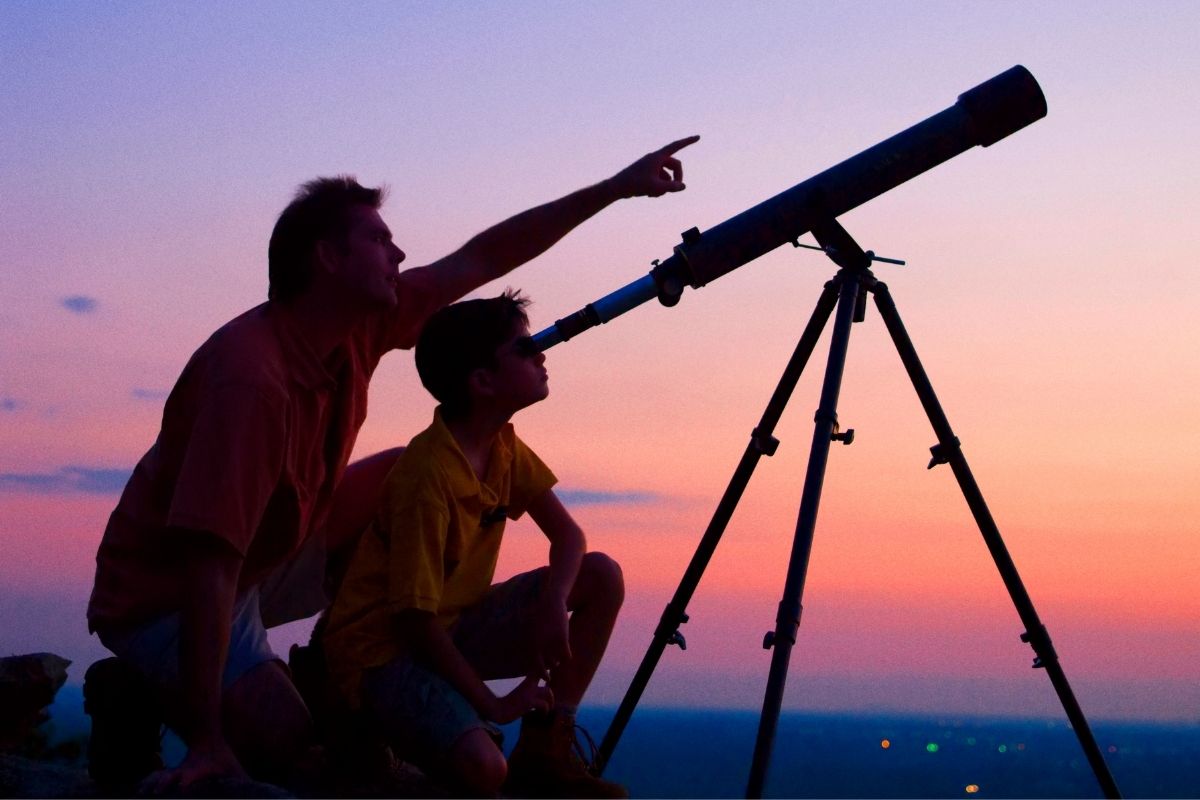Jupiter is the largest planet in our solar system, and its size and proximity to Earth make it prime for observing.
Learn how to spot Jupiter from Earth using binoculars or a telescope.
Jupiter is the fifth planet from the Sun and the third-brightest object in the night sky after the Moon and Venus.

The gas giant has four major moons, each named after Roman gods.
Jupiter’s diameter is almost twice that of Earth, and it takes 12 years for Jupiter to orbit around the sun.
But how do you go about seeing it for yourself? This article takes you through the steps of how to see the big, bright, and beautiful Jupiter using a telescope or binoculars, or seeing if there is any other way. Let’s jump in.
What Is Jupiter?
Jupiter is one of the most famous features in the Solar System. It was first observed by Galileo Galilei in 1610.
He noted that the red color came from the high concentration of organic compounds in the air.
These gases absorb light in the red part of the most recognizable features of this planet.
It appears as a large storm that measures approximately 1,200 miles (2,000 km) across.
Its name (The Great Red Spot) comes from the fact that it looks like a huge red eye staring back at us.
The Great Red Spot is now one of the biggest storms ever seen in space. It is so big that it can be seen with the naked eye.
The storm is caused by strong winds blowing over a region where the temperature is lower than normal.
Jupiter is surrounded by a ring of dust and ice particles called the rings of Jupiter.
The innermost ring is called the Encke Gap, which is named after the German astronomer who discovered it.
The outermost ring is called the Keeler Gap, and it was discovered by William Keeler in 1892.
The clouds of Jupiter are composed mostly of ammonia crystals and water vapor.
The atmosphere of Jupiter is very different from that of Earth because it contains no oxygen.
Instead, it consists of hydrogen, helium, and methane. Methane is also found in comets and meteorites.
In addition, Jupiter has a magnetic field that extends more than 100 times farther than Earth’s.
Jupiter is not only home to many moons but also has numerous volcanoes.
Scientists believe that some of these volcanoes may have been active during the formation of the planets.
Jupiter has two main belts of radiation. One belt is located near the equator and is called the E Ring.
The second belt is located near the poles and is called the G Ring. Each of these belts contains several dark spots on the surface of Jupiter.
Jupiter is a gas giant similar to Saturn. However, unlike Saturn, Jupiter does not have an iron core. Instead, it has a rocky core covered with liquid metallic hydrogen.
This makes it much easier to study than its sister planet.
Jupiter has four main known moons: Io, Europa, Callisto, and the largest of the lot, Ganymede.
Ganymede is immense. It’s even larger than Mercury and is considered the largest moon in the entire solar system.
There are several theories regarding why Jupiter has such a massive moon. Some suggest that it formed when Jupiter collided with another body.
Others think that Jupiter captured a passing star and then pulled it into orbit. Still, others believe that Jupiter swallowed a comet or asteroid.
But Ganymede and its three companions aren’t the only moons of Jupiter. Scientists now have good cause to believe that there are 79 moons of Jupiter in total.
Jupiter is the fifth planet from the Sun and the fourth-largest planet in our solar system. It takes 12 years for Jupiter to make one complete circuit around the sun.
That means that Jupiter completes one revolution every 10 years.
How Do I See Jupiter?

Jupiter is the brightest object in the night sky. If you look at Jupiter through binoculars or a telescope, you will see a brilliant orange disk.
The planet is about 400 million kilometers away from Earth.
You should be able to spot Jupiter with your naked eyes if you live in a place with clear skies.
You won’t need any special equipment to view Jupiter. All you need is a pair of binoculars or a good telescope.
Binoculars magnify objects so they appear bigger and brighter. Telescopes do the same thing, but they allow you to see things further away.
Binoculars work best at close range. A telescope can give you views of Jupiter as far away as the Moon.
Through a telescope, Jupiter is by far the most interesting planet to observe.
This is what makes it such a popular planet amongst astronomers. It’s the only planet that shows well defined, separate features, even with a very small telescope.
Its large moons hover around the planet, swinging around Jupiter’s globe, and this makes for incredible viewing.
Using Binoculars
Before you grab your telescope for Jupiter viewing, you could use your binoculars and find a dark wall to brace yourself against whilst pointing them toward the planet.
If your binoculars are high-quality and can magnify seven times (7×35 or 7×50) you’ll be able to see Jupiter as a very small white disk.
Look on to both sides of Jupiter’s disk and you should notice a sequence of small stars (3 or 4).
These are all Jupiter’s satellites and measure around the size of our Moon on Earth.
They look tiny and very faint because they are so much further away, yet are still pretty cool to spot yourself.
Using A Telescope
The biggest problem with observing Jupiter is the glare caused by sunlight reflected off of the planet’s cloud tops.
To reduce this effect, use a filter that cuts out all visible light except red wavelengths.
When you first look at Jupiter through a telescope, you need a low-power eyepiece to center the planet.
Focus so that Jupiter’s edge is as sharp as you can get it, let the vibrations settle, and take a good look up to the planet.
As long as you have a high-quality scope, the moons become much more clear and you will be able to see the four of them plus Jupiter of course.
The moon count often changes each night, however, so sometimes you may see three.
This is because when orbiting Jupiter they can glide in front or behind the planet, or even through its shadow.
Callisto is usually farthest from Jupiter. Ganymede is sometimes brighter, and sulfur-coated Io seems to have a pale yellow-orange cast.
However, it’s still sometimes hard to tell these apart.
Final Thoughts
We hope you have enjoyed this article about Jupiter and know how you can spot it for yourself when you feel like doing some planet gazing.
Jupiter is a fascinating planet and makes for some fantastic viewing.
So grab your binoculars or your telescope and take time to scan the planet slowly, taking note of the features you can see from Earth, as well as trying to distinguish the difference between its moons! It could well inspire a lifelong obsession with the night sky.
- I Can’t See Anything Clearly Through My Telescope – Help! - April 26, 2022
- Astronomy For Beginners – Getting Started Stargazing! - April 26, 2022
- Are Telescopes Easy To Use? - April 26, 2022
